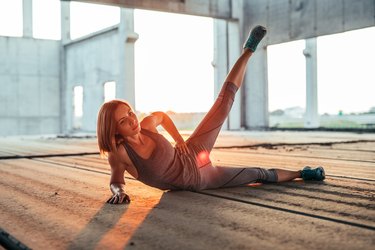
Lateral leg raises, also referred to as hip abduction, may seem to belong in 1982, but they have very real strengthening benefits. This single exercise utilizes multiple muscle groups and offers numerous functional advantages.
They're easy to do but proper form is essential to injury prevention. The term lateral implies movement away from the midline of the body. If done while standing, your leg moves outward and when lying down on your side, the motion is upward.
Video of the Day
Video of the Day
Read More: Top 5 Most Effective Leg Exercises
Form and Technique
Lateral leg raises may be performed standing, or while lying on your side.
How to do standing lateral leg raises: Stand up on your right leg with your back straight, keep the knee slightly bent. Holding your left foot a few inches off the ground, lift the leg as high as you can -- work towards about 45 degrees with the floor. Lower it back to the starting position and repeat.
Tips: Avoid bending at the waist to compensate for weak muscles, and rest your hands on your hips to keep the arms out of the exercise.
How to Do Lying Lateral Leg Raises: Keep one side of your body in contact with the ground, particularly from hip to ankle. Rest on your elbow, but ensure your back is in line with your legs and not leaning forward. Keeping your core muscled tight, lift your upper leg approximately 45 degrees and lower it in a controlled, smooth manner.
Benefits
Lateral leg raises focus on often-overlooked side-moving muscles. While toning the muscles in this area may improve your appearance, strong lateral hips and glutes help prevent injury. Adding these to your routine may help ward off knee, lower back, hip and IT band -- or iliotibial tract -- problems.
Muscles Involved
This exercise spotlights the hip flexor, core and abductor muscles. The hip flexor muscles include: the ilopsoas, which wraps around the groin area; the rectus femoris of the quadriceps; and the pectineus, which runs through the mid thigh.
Additionally affected is the longest muscle in the body, --the sartorius that crosses both the hip and knee joints. Core muscles cover the lower torso around your body and are comprised of the oblique, abdominals and lattisimus dorsi of the back. Lateral raises also improve strength in the abductor muscles, the gluteus minimus and gluteus maximus -- muscles of the buttocks.
Read More: 16 TRX Moves for a Full-Body Workout
Repetitions, Sets and Accompanying Exercises
Lateral leg raises, as part of a workout program, should encompass two to three sets of 10 to 15 repetitions. Accompanying exercises may include front leg lifts, squats, forward lunges, jumping jacks, burpees and mountain climbers.
To create a full body workout, do at least three each of lower body, core and upper body exercises. Core options are various crunches, hanging knee raises and flutter kicks. For the upper, try any type of push-ups, pull-ups, lateral or front arm raises and dips.